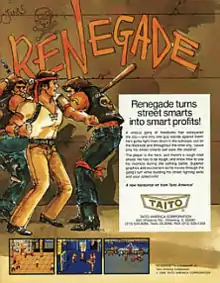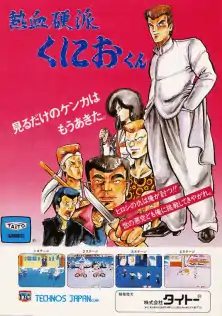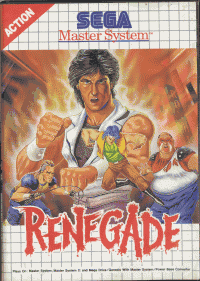Renegade (video game)
Renegade is a side-scrolling beat-'em-up developed by Technos Japan and distributed by Taito for the arcades in 1986.[2] The player controls a street brawler who must face four different gangs in order to rescue his girlfriend being held captive by a mob boss. The game was released in Japan as Nekketsu Kōha Kunio-kun (Japanese: 熱血硬派くにおくん, which loosely translates to "Hot-Blooded Tough Guy Kunio"), with this version of the game revolving around a high-school delinquent named Kunio who must stand up against a series of rival gangs frequently targeting his classmate Hiroshi. In order to make the game more appealing for the west, Technos produced a graphically-altered version with a visual style inspired by the 1979 film The Warriors, changing the looks of some of the game's characters and scenery. The first game in the Kunio-kun series, Renegade was ported to a variety of consoles and computer platforms.
| Renegade | |
|---|---|
 Game flyer | |
| Developer(s) | Technos Japan |
| Publisher(s) | Taito |
| Designer(s) | Yoshihisa Kishimoto |
| Composer(s) | Kazuo Sawa |
| Series | Kunio-kun |
| Platform(s) | Arcade, Amiga, Amstrad CPC, Apple II, Atari ST, Commodore 64, MS-DOS, NES, Master System, ZX Spectrum, Thomson, PlayStation 2 |
| Release | |
| Genre(s) | Beat 'em up |
| Mode(s) | Single-player, multiplayer |
Gameplay
Controls
The player controls a fighter (in the NES version, he is named "Mr. K" in-game, and "Renegade" in the instruction manual)[3] who must fight a variety of street gangs on the way to save his girlfriend from the gangsters. The controls consists of an eight-way joystick and three actions buttons; left attack, jump and right attack. Unlike previous beat-'em-ups such as Kung-Fu Master, Shao-lin's Road or My Hero, in which the player character's movement was limited to only left or right, in Renegade the player can also move towards or away from the background by pressing up or down in a matter similar to Technos Japan's 1985 wrestling game Mat Mania, although the battle system is still limited to only two directions. Pressing the attack button of the character's current direction will cause him to throw punches, while the opposite attack button causes him to perform a rear kick instead. When certain enemies are stunned after a few punches or a single kick, the player character can approach him for a collar grab and kick him repeatedly with the front attack button or perform a shoulder throw with the opposite attack button. While jumping, the player can press either attack button for a jump kick towards that particular direction.
Pressing the joystick left or right twice quickly will cause the player to run, at which point pressing the front attack button will perform a running punch, jumping will automatically perform a flying kick, and the rear attack button will bring the player to a sudden halt and perform a back-kick. Pressing down over a fallen enemy will make the player sit on top of them, at which point pressing the front attack will cause the player to pummel them. All of the boss characters (with the exception of Sabu) can only be sat on or put on a collar grab if their health is low enough, otherwise they'll push the player off.
The player has a limited amount of lives (which vary depending on the game's DIP settings) and no continues to complete the game. The player loses a life if he runs out of health after sustaining too many enemy attacks, gets knocked off the subway platform or into the sea in the first two stages or fails to complete the stage under the time limit. Health is automatically recovered at the start of each stage. Stages 2 and 4 are the only stages to have checkpoints in the middle of them.
Stages
Unlike Technos' subsequent game Double Dragon, the playing field is limited to a series of three-screen-wide areas and does not scroll continuously. The first three stages (a subway platform, a harbor and a street alley) each take place in a single area where the player must face against a gang of seven underlings with their boss watching from the background. The gang of the first two stages consists of two types of underlings: an armed thug who is easier to defeat, and an unarmed thug who can take more punishment and can grab the player character from behind.
When only three underlings remain (in any combination of the two) their boss will come in from the sidelines and join the fight. When the boss (Jack in the first stage, Joel in the second) is defeated, any remaining underling will retreat off the bottom of the screen, and the stage ends. Each boss character has their own health displayed underneath the player's. The second stage follows this same formula, but begins with a series of enemies riding motorcycles trying to run the player down. Once a certain number of bikers have been defeated (which vary depending on the difficulty level), the normal enemies will begin to face the player. The third stage features an all female gang. Like the first two gangs, the female gang also consists of two type of underlings: a weaker chain-wielding blond-haired type and a more resistant mace-wielding redhead type. The female gang leader (Kim) is a large woman who can easily grab and slap the player around. She's the only enemy in the game who cannot be put into a collar grab. The fourth and final stage consists of two areas and only has one type of underling, a bald knife-wielding hitman who can kill the player with a single stab. The first area is set in a parking lot where the player must fight against four of these hitmen. Once this first wave of enemies have been defeated, the player character automatically proceeds to enter a building at the far right of the stage. Inside, he faces three more knife-wielding underlings and the final boss, a handgun-wielding mobster (Sabu) who can kill the player with a single shot. Once the final boss is defeated, the main character exits the building and is greeted by his rescued girlfriend, who proceeds to give him a kiss. The game then begins the next loop with an increased difficulty.
Localization

Renegade is a localization of the Japanese Nekketsu Kōha Kunio-kun for the North American and Worldwide markets, with the game's graphics changed in an attempt to adapt the game's setting to a more western style (with what can be seen as thinly veiled 'inspiration' from the film The Warriors). The gangs of thugs and bikers featured in Renegade were originally high school delinquents, bōsōzoku members, a sukeban along with her minions, and finally Yakuza members in Kunio-kun. The subway level in the first stage was originally a Japanese train station, whereas most of the signs and billboards in the last two stages were also written in Japanese. The title of the Japanese version was influenced by Konami's arcade game, Shinnyuushain Tooru-Kun (known outside Japan as Mikie).
Instead of the damsel-in-distress plot of Renegade, Kunio-kun instead featured the titular high school student, Kunio (くにお), standing up for his bullied friend Hiroshi. Each stage begins with the stage's gang beating up Hiroshi in front of Nekketsu High School and Kunio chasing after his attackers. Unlike Renegade, Kunio and the game's bosses are identified by name in-game, whereas the characters in Renegade are simply identified by the generic identifier "1P" or "2P" (depending on who is playing) and "BOSS" (it was not until the NES version that bosses in Renegade were given names). The bosses of Kunio-kun are: Riki (りき), Shinji (しんじ), Misuzu (みすず) and Sabu (さぶ). The game ends with Hiroshi and several students of Nekketsu High School greeting Kunio outside Sabu's hideout, with Hiroshi giving Kunio a firm handshake. The game begins a new cycle, this time skipping the pre-stage introductions. Like Renegade, each character has a catch-phrase said by them in digitized voice, but spoken in Japanese.
The Family Computer version of Kunio-kun was Technos Japan's first game for a home console. After Nekketsu Kōha Kunio-kun, Technos Japan reused the Kunio character for several more games, beginning with Nekketsu Kōkō Dodgeball Bu (the Japanese version of Super Dodge Ball) released for the arcades and the Famicom/NES. Some were released overseas, such as River City Ransom (the American version of Downtown Nekketsu Monogatari), Nintendo World Cup (Nekketsu Kōkō Dodgeball Bu: Soccer Hen) and Crash 'n the Boys: Street Challenge (Bikkuri Nekketsu Shin Kiroku!), but most of them were released only in Japan. Kunio eventually became Technos Japan's official mascot, appearing on the company's logos in the intros of some of their later games, as well as in their Japanese television advertisements.
Ports

The Nintendo Entertainment System version, developed in-house by Technos and released in 1987 by Taito in North America, is a strong departure from the original arcade game; the first three stages each consist of a series of two-screens wide levels against a group of three enemies at a time, culminating in a one-on-one fight with the boss. The second stage also contains a side-scrolling motorcycle chase, in which the player tries to kick opponents off their motorcycles, prior to the boss fight. In the third stage, the player can choose from one of two paths after clearing the first level of enemies: one leads to a confrontation against the stage boss, while the other is a second level filled with small fry enemies. The fourth and final stage is a maze of numerous rooms, filled with enemies and previous bosses, inside a building which the player must proceed in order to reach the final boss. There are trap doors in this stage which warp the player back to a previous stage, forcing the player to begin all over.
The Master System version, developed by Natsume and published by Sega in 1993, is based largely on the NES port rather than the original arcade, but with enhanced graphics and several improvements like new death cutscenes and a revamped ending. This port was only released in Europe, Australia and Brazil.
Home computer versions were released for the Amiga, Apple II and IBM PC in North America and for the Amstrad CPC, ZX Spectrum, Atari ST and Commodore 64 in Europe. The American computer ports were developed by Software Creations and published by Taito, whereas the European computer ports were handled by Imagine Software and published by Ocean Software. They were typically limited to one fire button rather than three; the different moves are achieved by combining different joystick directions with a fire button press. The Amstrad CPC version mimicked the three-button control of the original by combining the joystick control with the cursor keys. The Spectrum and Amstrad versions use flip-screen rather than scrolling levels.
Reception
| Publication | Score |
|---|---|
| Crash | 89%[4] |
| CVG | 88%[5] |
| Sinclair User | 8/10[6] |
| Your Sinclair | 9/10[7] |
| The Games Machine | 87%[8] |
The Spectrum version was voted number 48 in the Your Sinclair Readers' Top 100 Games of All Time.[9]
Legacy
The NES port of Renegade was released for the Wii's Virtual Console in North America on May 5, 2008 at a cost of 500 Wii Points.[10][11] It was re-released on February 27, 2014 both on the 3DS Virtual Console and Wii U Virtual Console.[12][13]
On June 28, 2018 a port for the Nintendo Switch was released by Hamster as part or their Arcade Archives series.[14] This port includes both original US and Japanese arcade game, making it the first time the original Nekketsu Kōha Kunio-kun being released in the west commercially.
Sequels and related games
Ocean Software produced two sequels to Renegade: Target: Renegade, and Renegade III: The Final Chapter. These were released for the ZX Spectrum, Commodore 64, Amstrad CPC and MSX, but never had corresponding arcade versions. Target: Renegade was also released on the NES.
Technos was slated to release the Game Boy title Nekketsu Kōha Kunio-kun: Bangai Rantō Hen as a follow-up called The Renegades, but it was eventually retooled as Double Dragon II and published by Acclaim.[15]
Technos produced numerous games starring Kunio in Japan. Some of these were localized in North America as Super Dodge Ball, River City Ransom and Nintendo World Cup. Technos had no involvement with the Ocean-produced Renegade sequels.
In popular culture
Manga artist Mizuki Kawashita has named one of the characters in her best known manga, Ichigo 100%, Misuzu Sotomura after the game character of the same first name.[16]
References
- "The Year In Review". Cash Box. January 17, 1987.
- "Game Machine's Best Hit Games 25 - テーブル型TVゲーム機 (Table Videos)". Game Machine (in Japanese). No. 287. Amusement Press, Inc. July 1, 1986. p. 25.
- "Game's Instruction Manual" (PDF).
- "World of Spectrum - Crash-44".
- "World of Spectrum - Computer & Video Games-99".
- "World of Spectrum - Sinclair User-67".
- "Archived copy". Archived from the original on September 8, 2012. Retrieved September 5, 2012.CS1 maint: archived copy as title (link)
- "World of Spectrum - the Games Machine-1".
- "Readers' Top 100 Games of All Time". Your Sinclair. September 1993.
- "Pokémon Puzzle League and Renegade Now Available on Wii Shop Channel!". Nintendo of America. May 5, 2008. Retrieved May 11, 2008.
- "Renegade".
- "Renegade".
- "Renegade".
- "Article 48—AMERICAN TECHNOS THE RENEGADES FLYER". VIDEO-GAME EPHEMERA.
- ichigo 100% vol.19: Shuisha 2002
External links
- director yoshihisa kishimoto HP
- Kunio-kun at Hardcore Gaming 101.
- Renegade at SpectrumComputing.co.uk
- Renegade on the Amiga at The Hall of Light (HOL)